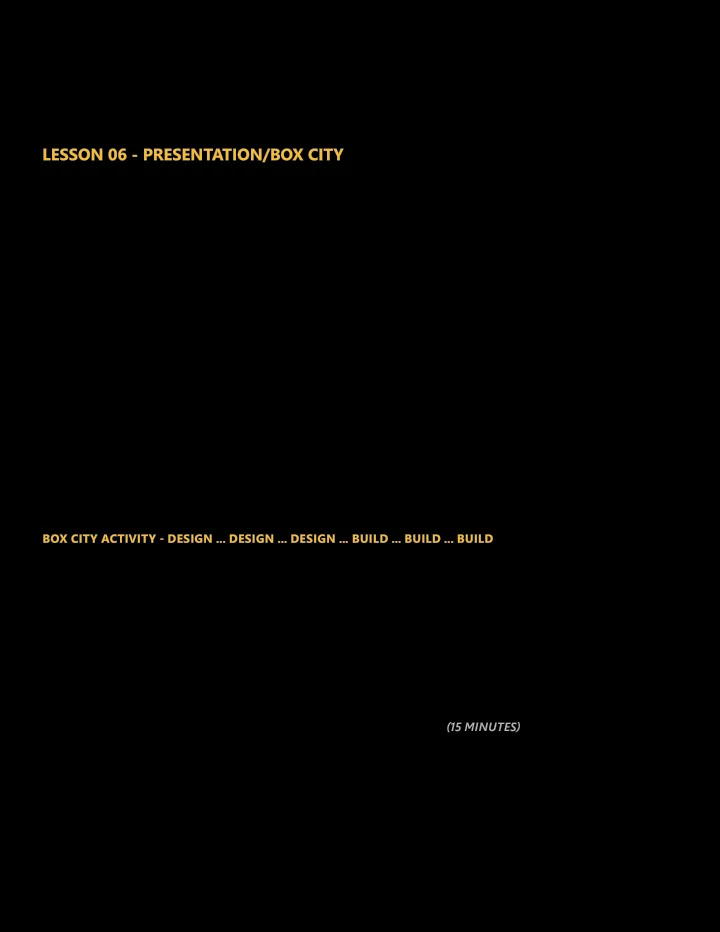

EDUCATING ELEMENTARY CHILDREN THROUGH ARCHITECTURE AN INTERACTIVE ARCHITECTURE LEARNING UNIT FOR ELEMENTARY STUDENTS LESSON 06 - PRESENTATION/BOX CITY TIES TO CURRICULA (5TH GRADE - LANGUAGE ARTS) Speaking and Listening Standard 1: Engage efgectively in a range of collaborative discussions with diverse partners on grade appropriate topics and texts, building on others’ ideas and expressing their own clearly. SUMMARY Classes will be able to display their work at a fjnal showcase, usually celebrated with a short presentation of participant work and experience. Teachers and Volunteers, with the help of student parents and aides, will need to coordinate delivery and set up of their classroom’s city. The Box City installation will then be open to the public for a few days. At the end of the display period, representatives from each class will be responsible for removal/disposal of their city. Some classrooms and schools may also wish to have their own type of fjnal showcase, which should be coordinated as needed. For some student’s, presenting your own ideas in your own way can be very frightening. As time allows, have the students explain their building designs and block layouts. Encourage them to describe their designs using vocabulary introduced in previous lessons. Have students talk about their favorite lesson or favorite part of their classes’ Box City. MATERIALS Classroom/Teacher: Architect/Volunteer: ** optional ٠ scissors, tape, glue, colored paper ٠ Handout 6.1 (copies for each student) ٠ butcher paper ٠ Handout 6.2 (copies for each student) ٠ any additional materials need to fjnish up Box City (as determined by Teachers and Volunteers) ** BOX CITY ACTIVITY - DESIGN ... DESIGN ... DESIGN ... BUILD ... BUILD ... BUILD Have students get in their groups and work on their Box City buildings and blocks. Use the following checklist: (required) fjnish design and models for building typologies (From Lessons 02-04) ٠ façade layouts, materials, colors, etc. (cut and paste or draw) (required) place roads and streets (Lesson 05) ٠ students may draw roads or glue down paper or other materials to identify roads and other city elements (optional) show sidewalks and bike lanes/paths (optional) identify nodes, edges, districts, etc. (Lesson 05) (optional) attach models of building typologies to map and/or arrange for city transportation to library (optional) design and place bridges (if necessary) (optional) place trees, cars, and the pipe cleaner person (Lesson 01) to show scale anything else you think is important to your classes’ city LESSON ACTIVITY 1 - PRESENTATION SKILLS AND DOCUMENTATION (15 MINUTES) As the groups fjnish their Box City, distribute a copy of Handout 6.1 and 6.2 to each student. Have them fjll out their own worksheets to allow them to individually describe what they have created. If time allows, have each student orally describe their Box City building or block. We encourage you to take lots of pictures, and video if allowed, to document the experience. For inclusion in the fjnal showcase, please send pictures, videos, and completed handouts to Hoku Ching (hching@vcbo.com) the week before. RESOURCES Architecture in Education: A Resource of Imaginative Ideas and Tested Activities Foundation for Architecture, Philadelphia; Edited by Marcy Abhau with Rolaine Copeland and Greta Greenberger Architecture is Elementary: Visual Thinking Through Architectural Concepts by Nathan B. Winters
LESSON 06 - PRESENTATION/BOX CITY HANDOUT 6.1 INSTRUCTIONS Look at what you have designed and created for your classes’ Box City and answer the following questions. 1. From the fjve types of city organizations, what organization did you use for your Box City? Use Handout 5.1 from Lesson 05 to help you. 2. Describe the design of the model for your building typology. What is the building used for? What materials are shown on the model? Are there any colors? What scale is the model? How far is it from the street? Where do people enter? What is your favorite part of the model? 3. Describe where the neighborhood edges are in your box city section. 4. Are there any parks or open green spaces in your box city section? How do people get to them? What types of buildings are next to the open green spaces? 5. Are there any city nodes in your box city section? Describe where they are and why you have them. 6. Where are the streets in your box city section? Where do pedestrians walk? 7. Are there any natural landforms in your box city section? If so, what types of buildings are next to them? Can people walk to these places? 8. Would you like to live in your box city? Explain your answer. UCFA - UTAH CENTER FOR ARCHITECTURE EDUCATING ELEMENTARY CHILDREN THROUGH ARCHITECTURE
LESSON 06 - PRESENTATION/BOX CITY HANDOUT 6.2 FINAL BOX CITY PRESENTATION SHEET NAME GROUP NAME BUILDING TYPOLOGY Using thoughts from Handout 6.1, write a paragraph describing your Box City neighborhood. Write as if you are describing it to someone who is visiting for the fjrst time. Why would they want to come here? How do they get around? What is your favorite part of your neighborhood? NEIGHBORHOOD DESCRIPTION GET A NEIGHBORHOOD PICTURE (see Teacher or class Architects/Volunteers) Using thoughts from Handout 6.1, write a paragraph describing your Box City building. Write as if you are describing it to someone who is visiting for the fjrst time. Why would they want to come here? What is the building made out of? How is it shaped? What is your favorite part of your building? BUILDING DESCRIPTION GET A BUILDING PICTURE (see Teacher or class Architects/Volunteers) UCFA - UTAH CENTER FOR ARCHITECTURE EDUCATING ELEMENTARY CHILDREN THROUGH ARCHITECTURE
Recommend
More recommend